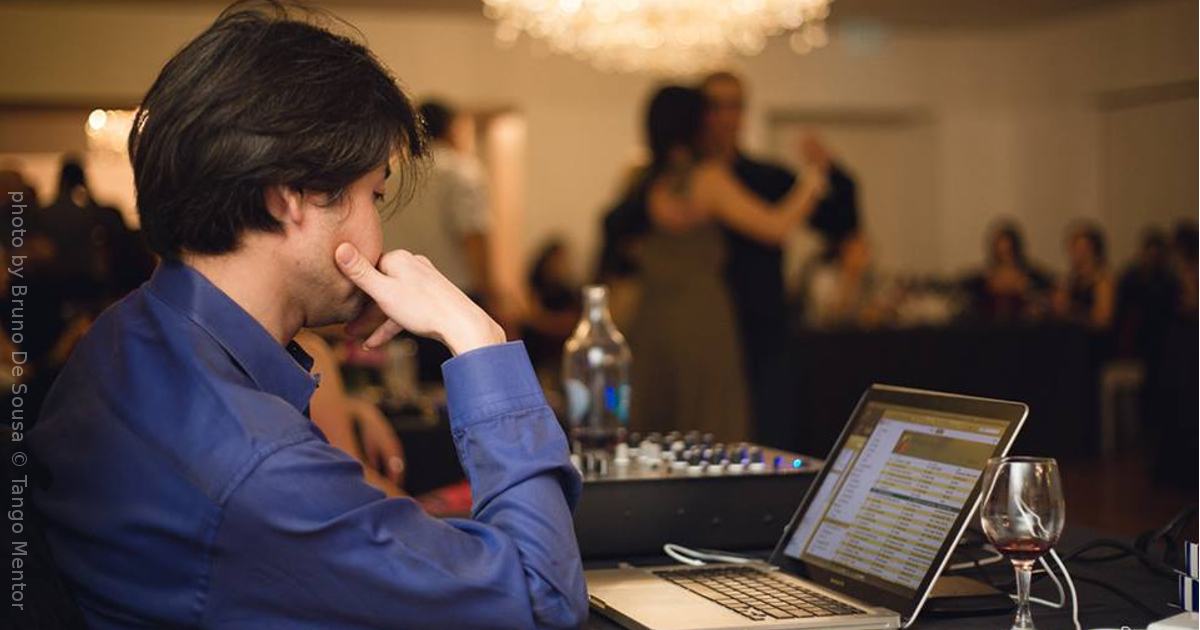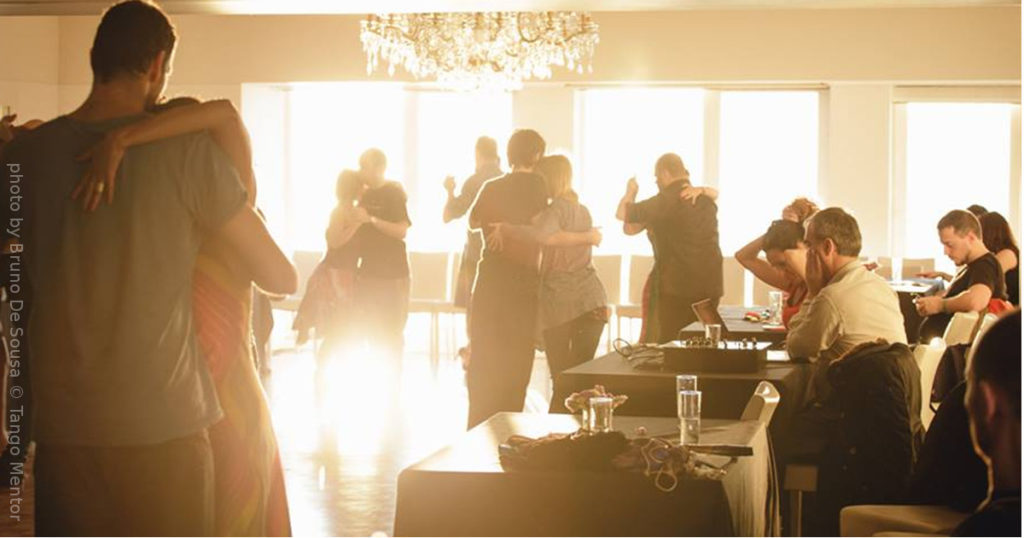
If one can say that the DJ has superpower, than it’s his ability to control how the milonga unfolds. The mood of the dancers is often influenced by other factors as well, but the music selection can make or break the milonga.
How does DJ’s choices actually work? What are the tools in his/her toolbox? What knowledge he/she should have?
Well, the short answer is that they have a lot of tools. Some are simple, other require some experience. In this article I will talk about some of the tools I learned during almost 8 years of DJing around different international events.
The milonga tanda just finishes and dancers go back to their seats or part of the room where they make invitations. The cortina slowly fades away into a dense silence. Dancers look across the floor for the possibility of invitation…
But no invitation is made before they recognize the the first notes of the tanda. They wait!
The silence seems too long, but then something happens… a piano: taam-taaaaaaaaam… with staccato violins in the background: tan-tan-tan, tan-tan-tan, tan-tan-tan… You always hear one long “aaaaaaaah” when the excited dancers recognize the intro. It’s Fresedos “Buscandote”. No matter if they heard it a hundred times or more – people just love that song.
Good DJs know that and, more importantly, they know how to use that knowledge.
Listening and feeling the music is highly subjective experience. For this reason the stuff I am talking about here can differ in different environments and in different times. The DJ should develop his/hers ability to recognize those differences and react accordingly.
It’s not enough to just have good collection of tango music – you have to know how to use it. A DJ should observe how the music he plays influences those who dance and learn how to use the right music in the right moment.
1. Melody vs rhythm
The simplified formula would be: use rhythmical music to make them feel playful and use melodic music to make them emotional.
In my experience people respond to rhythmical music with focusing on their steps. They open up to their creative side and become more eager to experiment. They laugh and enjoy the physical side of the dance.
On the other hand, melodic tandas can turn the focus of the dancers more to their emotional side. Their connection becomes deeper, there’s more passion and sensuality. You can see less smiling and more sadness painted faces.
Some rhythmical orchestras to consider:
- D’Arienzo
- Biagi
- Rodriguez
- Tanturi
- Donato
- Canaro
Some melodic orchestras to consider:
- Di Sarli
- Fresedo
- Demare
- Caló
- Pugliese
- Laurenz
- Troilo
2. Fast vs slow
In my opinion playing slow music is the most dangerous thing one DJ can do: it’s like walking on the edge of a cliff.
Slower can be stronger and deeper, but I believe every DJ should use slow music with extra caution.
Playing slow tanda should be in the right moment and with the right choice of orchestra. If you play it too early it might destroy the mood of the milonga; if you play it too late, there might be no dancers – all would have been gone home tired from the fast music you played.
Dancing with slower movements is much harder than dancing faster. This is why the DJ has to find the right amount.
What is the difference between the slow and the fast music? Fast music energizes dancers, makes them jump from their chairs, they invite their favorite dancers who have more technical skills… The fast music is specially effective if its in the same time rhythmical – it is a killer combination.
The slower music, on the other hand, makes people feel heavy. They feel every step much stronger. Dancers who dance on slow music are often more grounded and the ronda suddenly becomes quiter. It’s heavy and meditative music, and it brings those feelings on the dance floor.
Some fast orchestras to consider:
- D’Arienzo
- Biagi
- Tanturi
- Rodriguez
- Fresedo
- Troilo
- Donato
- Canaro
- Lomuto
- Caló
Some slow orchestras to consider:
- Di Sarli
- Pugliese
- Garcia
- Laruenz
- Demare
- D’Agostino
Hey, sorry to interrupt…
Do you like reading my articles? If you do please consider a small contribution to the existence of this blog.
I don’t sell a book or run ads: I share these articles for free. Unfortunately I also have to pay my bills, so if you see value in my work please consider a small donation/gratuity (the same way you tip your favorite bartender).
From my heart to yours!
Ivica
Securely processed via PayPal
3. Simple vs complex
Usually the traditionalist line of the tango music (like Canaro or D’Arienzo) is considered to be less complex than the line of the innovators and “artists” (like Pugliese or Troilo). It is also noticeable that the older music is usually less complex than the one recorded later on, or played by orchestras that came later in the history of the tango music.
Beginners are usually impressed with complex music first, but no matter what the DJ should be aware that their mood goes up when they dance to simpler. Why? Because it’s less demanding and their technical skills are still not mature enough for complex music. For example, they love to dance to Canaro or Di Sarli.
What can a simple tanda do for the DJ? First of all – it can start the milonga in a smooth way, giving the dancers enough time to get on the track and warm up. It starts the dancers musicality engine.
I used simpler music later on during the evening as well as well, but only when I noticed that the mood goes down and the milonga needs a restar. Consider the simple tanda to be the great tool to reset the milonga, or starting a new mini set.
DJs should try not to experiment with complex tango music if the level of dancing is poor. Beginners will dance much better with simple music.
On the other hand, advanced dancers get easily bored if you don’t give them a little challenge. One should here also play smart and avoid going too far. There should always be a balance between simplicity and complexity.
The complex music usually has a lot of surprises: slowing down, pauses and so on. It can also sometimes use irregular rhythmic patterns.
Some complix orchestras to consider:
- Troilo
- Pugliese
- Tanturi
- Demare
- Caló
5. Old vs new
Different people – different tastes. I can notice a split between festival and marathon on one side, and encuentros on the other. Namely, the festival/marathon world DJs lean towards music that was recorded latter (even in the post-Golden Age period); on the other side, encuentro DJ’s tend to use older recordings.
Well, I don’t like both approaches. Why? Marathon DJs use music recorded after 1950s, which in my opinion is unacceptable in 80% of the cases.
On the other side, I feel this tendency among encuentro DJs to focus too much on older music (most often, but not necessarily the Old Guard).
The best tango music is recorded in the Golden Age – the period between 1930s and 1950s. I believe that the good DJ should be aware of that and use it in his/her advantage. It’s wrong approach to give up the richness of the Golden Age no matter what’s the reason behind that.
But what does the old music brings to the dance floor?
First, it brings warm atmosphere. It has this little bit old jazzy mood and it makes people feel welcomed and happy. If the milonga is half empty, the DJ can answer to the emptiness and coldness of the mood with some older tandas. It’s just feels friendlier – no wonder some people enjoy the hear that vinyl crackling sound in the tracks.
On the other hand the newer music brings deeper expression to the dance floor. It has bigger emotional charge and, in some cases, a drama.
Some older orchestras to consider:
- Carabelli
- Orquesta Tipica Victor
- Canaro
- Fresedo
Some orchestras with newer music to consider:
- Pugliese
- Caló
- Di Sarli
- D’Arienzo
- Biagi
- Racciatti
6. Hits vs less known music
Hits make people jump to dance, good music which they hear for the first time gives them wings. In my experience a good set consists of 70% hits, 20% less known music and only 10% (or less) of music which the crowd do not recognize. This implies that a good DJ has to know the taste of the dancers and the level of their knowledge.
I could have easily named this point Hits vs education, but I didn’t. Why?
DJs are often considered the most educated members of the tango community – which means they investigate, search for the music, check the quality, read the history. Doing so, sometimes they notice that their community is unfamiliar with part of the rich musical heritage of the tango. Their job is sometimes to introduce new songs and new orchestras.
New music also refreshes the mood. Listening to the same music over and over again can sometimes take away the energy – this is why new piece from time to time can be refreshing. This is especially good if you have advanced dancers on the floor – this is a kind of challenge which they will accept with gratitude.
When playing unknown music DJs should pay attention to danceability. If the song is unknown there must be a reason for that: sometimes some tracks are not played for the simple reason that they are bad and undanceable.
The principles of danceability
When people recognize a song they feel in a familiar territory. They feel comfortable to invite and to accept invitation. Among the hits are often the favorite songs of many people. Playing a hit for the DJ should be a tool to invite everyone on the dance floor. I recommend to all DJs to start every tanda with a hit.
What’s your experience? Please share in the comment section bellow and share the post with your friends, so they can benefit from its content.


